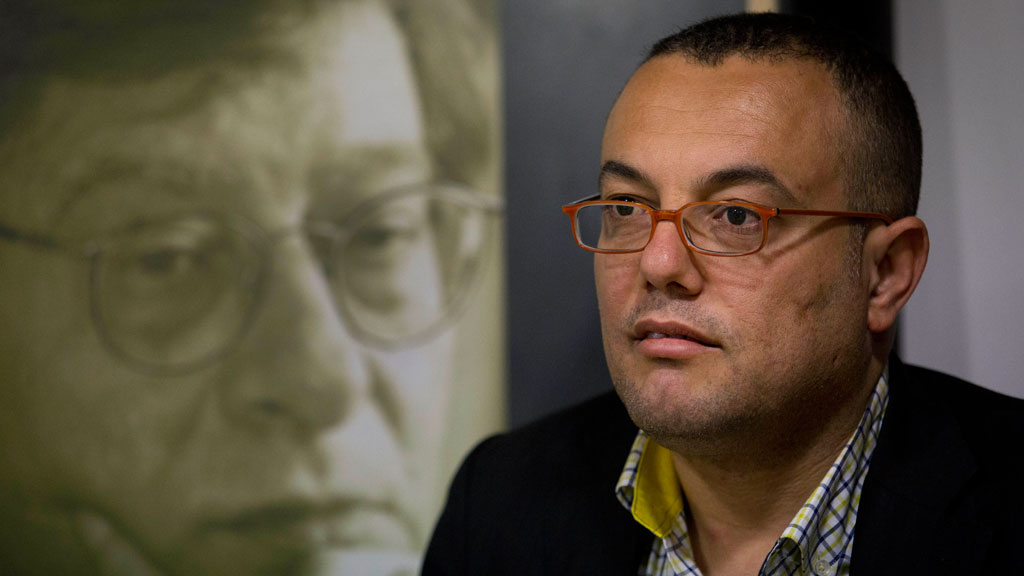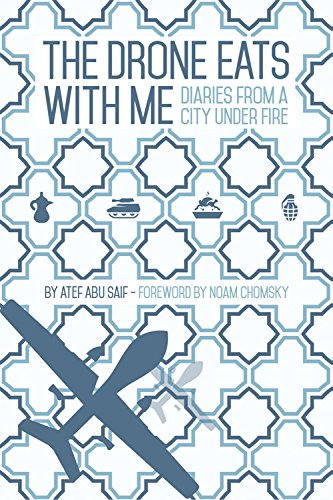A war without distinct edges

War is among literature's most constant companions. Violent conflict has shaped and shaded the epic poetics of Homer and Antarah, the dark memoirs of WWII death camps and the recursive novels of Lebanon's civil war. Each new face of war has inspired, or perhaps demanded, a new sort of literary engagement. War's newest face – impersonal drone attacks –is a tale still undertold, particularly from the non-combatant's perspective. But civilian life during drone war has found a great new literary chronicler in Gazan novelist Atef Abu Saif.
Abu Saif's "The Drone Eats with Me: Diaries from a City Under Fire" tells the story of invasion from the point of view of a non-combatant. In it, we hear less about soldiers and tactics than we do about the faceless metal warriors whirring overhead. This is the story of an invasion that is low-contact, low-casualty for the invader and high-contact, high-casualty for the invaded – the story of "anti-terrorist" warfare. In particular, this is war in the Gaza Strip in the summer of 2014.
"The Drone Eats with Me" is structured diary-style, from the beginning of the war to its end, although both are unstable moments. As the narrative opens, we are unsure if war is beginning, will begin, or has already begun. Throughout, we are equally unsure if war is ending, and how we might recognise this "ending" when it comes. Abu Saif's older children are constantly asking if the war is over. Even Abu Saif's emphatic declaration of survival after a treaty is signed is overshadowed by the afterword, which admits that "the war goes on".
Just as this is not a war without distinct edges, Abu Saif doesn't give us a bird's-eye view of the conflict's competing parties. We hear nothing about Hamas or Fatah, Labour or Likud. Although Abu Saif is a compelling political thinker with a doctorate in political science, in "The Drone Eats with Me" he wipes out political labels and specificities. Nearly all of the politicians are nameless, and Palestinian militiamen appear without party or allegiance. People shout slogans, but we don't know their content. We are held absolutely to what it's like to live through this war. We know little about what started it, or what happens outside its confines.

War as a weather event
Throughout the 51-day narrative, we are trapped inside the shower of missiles and whir of drones, such that it feels more like a weather event than a military attack. We calculate risks alongside the author, are annoyed alongside the author, feel suffocated and frustrated alongside the author. We too walk down the street hoping to avoid the attention of the drone glinting overhead, wondering if it's better to walk under the trees (which might absorb some of the impact) or in the centre of the street (away from buildings).
But if it's a weather event, we are not meteorologists. Drones, F16s and tank incursions appear without apparent pattern. In the place of narrative or political logic, we have only the magical logic of the survivor: if we go here, if we do this, if we knock three times and avoid these habits, then we just might be safe.
As the 51 days pass, the fights that we see are not political ones for freedom or justice. Instead, they're battles over limited water supplies and who spends too much time in the bathroom. One night, there's a fist fight in one of Gaza's open-air markets. People who have lost their homes think the sweet-sellers are being insensitive by peddling chocolates ahead of the Eid holiday. "Shouts were heard and then fists thrown, right in the middle of the souq, turning everything into a mess."
Although the Israeli soldier occasionally appears, the titular drone remains the central antagonist. The drone here is anthropomorphised: it eats, sleeps, drinks and gazes into Abu Saif's living room. Occasionally, Abu Saif imagines the nameless and faceless Israeli soldier, but this soldier is always secondary to his drone.
The Palestinians too become alienated from themselves. The video-game nature of distance warfare brings a new sort of dehumanisation. In the middle of the war, Abu Saif quotes from a conversation between nameless Gazans: "I spent that day running between shells like I was playing a video game. Like I was a character in the game, someone else was playing me."
The hallucinogenic absurdities of war

The memoir is at its most powerful when it embraces the war's hallucinogenic absurdities. Abu Saif usually writes his creative work in Arabic, and his English sometimes forces a plainness on the prose. But there is still beautiful writing. Near the beginning of the war, "The street looks like a sculptor's workshop, fragments everywhere, and yet the form of his subject is still deep in the stone, yet to reveal itself."
The memoir weakens when it turns away from the action, telling its reader there are no words for the horrors before us. In these moments, we stand alongside Abu Saif, blinded, not because there aren't words to describe events, but because he can't bear to use them. This is particularly true when the raw violence comes close to him, as in the case when his stepmother loses a son.
For readers who care about human rights, it is tempting to extend magical properties to a book like "The Drone Eats with Me". Instead of seeing it as a story of modern warfare, written by a powerful wordsmith, it is tempting to frame it as a book that will intervene in political life. The UK edition is certainly framed as such: there is a shrill foreword by Noam Chomsky and a footnote on nearly every page, backing up Abu Saif's memoir with "evidence" from news stories, YouTube videos and elsewhere.
A forthcoming US edition will wipe out this framing, Abu Saif says. In that edition, we can hope the book will be seen in its most powerful form: as a very human story of what it means to survive 51 days of contemporary drone warfare.
Marcia Lynx Qualey
© Qantara.de 2015
